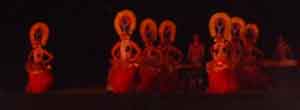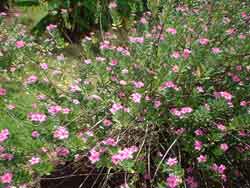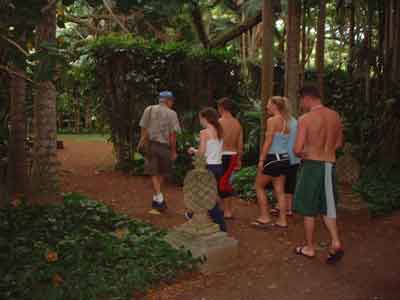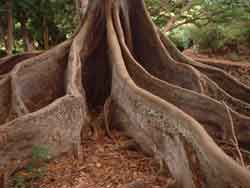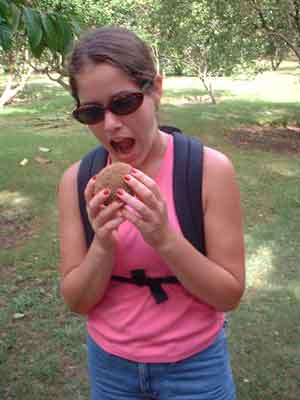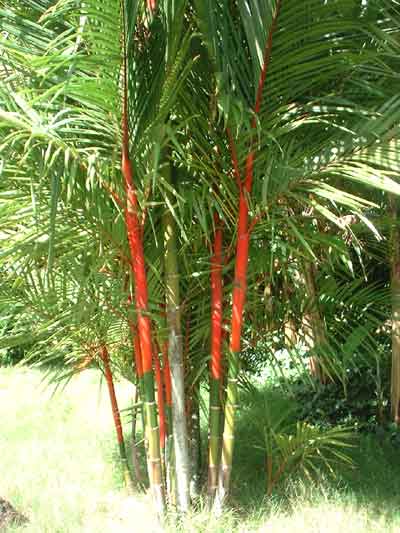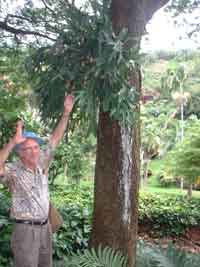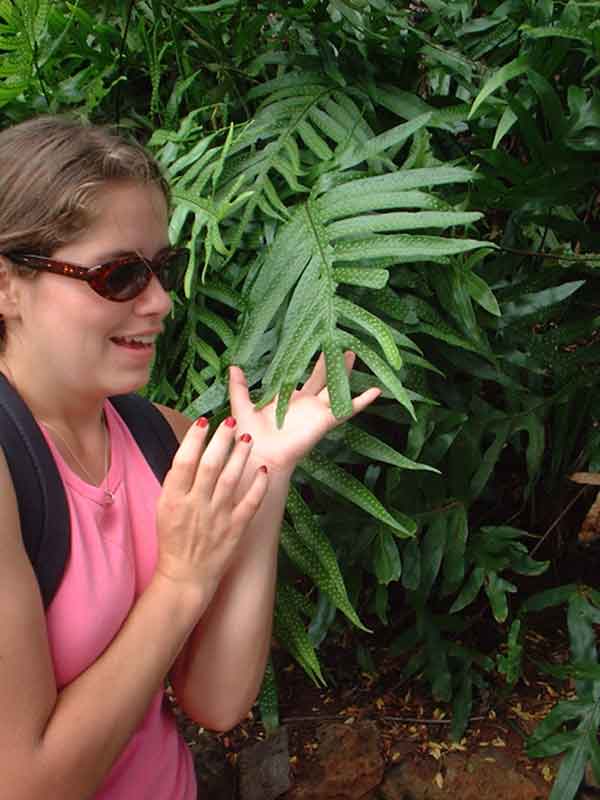Kalalao || Sugar || Garden || Grotto || Cruise || Luau || Waimea|| Home
|
Kauai, Journal
The photo part of the journal is online: http://www.lisaswanstrom.net/hawaii.html
Day 1: June 30, 2002: The Beach at the Plantation Hale Although a good part of the first day was spent in flight, we managed to swim at the beach across from the Plantation Hale as soon as we arrived. On the way to the ocean we saw salt cedar, which looks something like a shorter, fluffier hemlock, and many flowering plants, including heliconia, plumeria, and hibiscus. Around the Plantation Hale I also noticed a lot of palm trees, which make a nice rustling sound when the wind blows or it rains. Once we hit the ocean, we found that the waves were larger than what we were used to, but the water was warm, and splashing around in it was fun. The bottom of the water was a little bit rocky, with large patches of sand, and a few people stubbed their toes against it when a particularly large wave swelled. The sand on the beach was a little more golden than California sand, and much moister. When you walk across the sand in Kauai, your feet sink into it, pushing holes with your heels. I imagine this has something to do with the humidity and frequent rain, but I'm not sure. Regardless, it feels good! The moist air feels good too, and I noticed that my skin was less itchy in Kauai than it usually is in California. It reminded me of Florida, in fact, where I never had to use moisturizer. This kind of air also seems really good at holding a perfume. I don't know if there is a scientific reason for this, but I could smell the flowers from our patio--and I could certainly smell the rain.
Day 2: July 1, 2002: The Kalalao Trail Today we drove to Kee Beach, which is west of Hanalei, and hiked on the Kalalao Trail. We hiked from Kee Beach to another, more isolated beach, and swam in the large breakers. I thought I was pretty "wave savvy" until I went out for a second round. This time I got tossed rear over teacup and landed on my head. It was still fun, and I went a few more times before calling it quits. The hike itself varied in terrain from dry earth to wet rock to fern covered pathways and flowing streams. Almost everyone fell at least once on the slippery rock, but no one got hurt. At one point early on there was a ridge from which you could look down onto the Na Pali coast. A couple of other hikers pointed out a whole pod of dolphins in the ocean, surrounding a motor boat. Some of dolphins did dives and flips in the water. On the hike we also saw a red-crested cardinal, river pollywogs, tiny fish and, strangely enough, a small black cat that purred when I scratched its neck. As far as plant life, we saw plenty of octopus trees, with roots like straight wooden tentacles, various ferns and shower trees, and plenty of jungle vine, from which Andrew swung and played Tarzan. There was also coconut palm (we heard but did not see a coconut fall on one of the cars in the parking area), sea caves, and waterfalls no thicker than a finger. My favorite part of the hike was the return to Kee Beach, with calm, clear water that is flat as liquid glass. Erika and I went swimming there for a while, rinsing off the sand and mud from the hike. It was there, floating in the turquoise water, that we saw the wild and raucous "sea turkey" stalk across the beach. This sea turkey was Pete, who waddled across the sand with a palm frond stuck in his shorts that looked like a tail feather. I think some of the legitimate jungle fowl ran in fear. That night we went to the Hula Girl for dinner. There we saw two people dance the hula, and heard various songs (including one Elvis tune) on the ukulele. The three female musicians all wore muu-muus. They pointed out that the word "mu-mu" means cow, and that they were wearing muu-muus, which means something entirely different (a long loose-fitting dress).
Day 3: July 2, 2002: The Sugar Plantation and the Botanical Gardens At the sugar plantation we rode on a horse-drawn buggy and looked at the fields of sugar cane. I had no idea that sugarcane could be put to so many uses. Besides providing table sugar, light brown sugar, dark brown sugar, molasses, refined molasses, and contraband rum, the cane also produces the by-products ethanol and bagasse. I am not sure what ethanol is used for, but bagasse is used as a fuel source, similar to wood. After the cane has been squeezed of its liquid sugar, the leftover bagasse is substance that is similar to wood chips and burned for energy. At the sugarcane plantation I also saw what might have been an African tulip tree. Afterwards we drove to the botanical gardens, and there, under the shade of a giant monkey pod tree, we were told that 95% of Hawaii's plant life was introduced and invasive. I have mixed feelings about invasive plants. The monkey pod tree, for example, is an introduced species, yet it is a large and lovely tree that provides both ample shade from the sun and a giant umbrella against the rain. It also sheds crescent shaped pods that range in color from light caramel to rotten banana. The Himalayan blackberry, another tenacious invasive, has found a home on Hawaii as well (it is also in Yosemite). Yet blackberries taste good! I don't know how I feel about ripping them out of the ground. I understand that ecosystems are fragile, and we need to maintain a delicate balance between native plants and animals and foreign adversaries, but I sometimes think that we're fighting a losing battle. I wonder what alternatives exist--if there is a way to maintain native plants while accommodating the introduced varieties. Before the garden tour, we also saw a macadamia nut tree that was covered in a shawl of wood vine. Erika said the vine looked like Raman noodles, and she was right. It was a beautiful plant, forming a sort of cave-dome around the tree, blocking the rain and giving shade. However, this vine was slowly choking the macadamia, blocking its light and inhibiting photosynthesis, acting like a wooden spider web around a living tree. After we left this part of the tour, we met Dean, who showed us a beautiful quilt he had just finished, who has just published a book on the moths and butterflies of Kauai, and who gave us an amazing tour of the botanical gardens. I don't know if I can remember half of what he told us, but here it goes: First of all, Rosy Periwinkle is used to help treat leukemia. It is a smaller flower, more purple than rose, and looks almost like a violet colored jasmine, but with thicker, rounder petals:
Rosy periwinkle Panex is a bamboo-like plant that can be used to fence a garden:
Panex In the picture, we are walking towards a hedge of panex. Next, banana trees do so much better in Kauai than they do in California (in my mother's backyard, for example). My mom's plant has produced suckers once, but has never grown over five feet tall. The banana trees here were so large I did not recognize them:
Banana trees
Banyan trees have roots that grow backwards from the top of the tree. They might be invasive, but they are gorgeous trees, with fanning wood:
Large Ficus
Incandescence has two distinct parts that hand side-by-side. The first looks like a cluster of pale dried berries, almost white, and hangs downwards like a string of grapes. The second part is even more fruit-like, and looks like like a cluster of rotten grapes, but is not as squishy--almost like a string of maraschino cherries. Both the parts are longer and more linear than a cluster of grapes, but I wonder if they're related, since they both have a drooping cluster formation. Besides all of this we saw heart-shaped skunk pods and soft breadnuts that felt like nerf balls but smelled like citrus: 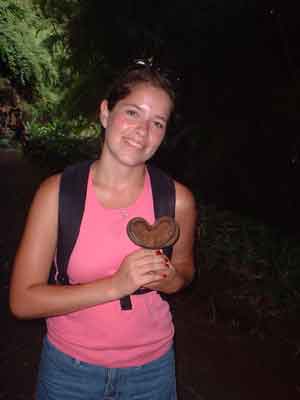
Erika with skunk pod
Erika with breadnut We also saw fig palm, fan palm, coconut palm, and wax palm, which has a sort of tropical Christmas coloring:
Wax palm Dean also pointed out staghorn fern, which curves like the horns of a stag:
Staghorn fern on a tree One of my favorite parts of the tour was when Dean handed out a bunch of cocoa berries and crushed them into our hands. They smelled like rich, dark chocolate. I would have eaten the power if it hadn't been for the pesticides:
Cushed cocoa berry I also found out that the fern I had been seeing everywhere was called the ascus fern (ascii) and was covered with spores:
Erika with sporing ascii We also saw plenty of hau trees, which turn from yellow to red when the blossoms die. The last thing I remember from the botanical gardens was a crab spider that had its legs doubled together so it looked like an "x." Day 4: July 3, 2002: Snorkeling along the Na Pali Coast I saw a shark! Although a lot of other things happened today, this is all I remember with any sort of accuracy. It floated out from under the reef like it was following a track beneath its belly. It was about five feet long and had a soft blue color. I have since learned that it was a white-tipped reef shark, but at the time it just seemed like a blue Jaws. I have never swum faster. It was a beautiful animal, though, and I'm glad I saw it. Besides the shark I saw a whole bunch of different fish, including a darker fish with violet lines around its body; a bunch of silvery flat fish; a school of silvery pink fish; and then, the coolest fish of all (besides the shark): a fish that looked like a bird, because its nose was shaped like a honeycreeper's bill. Its bill was orange, but the rest of the body was black. He was the only one of his kind that I saw. We also saw a green sea turtle that swam by, and lots of little neon fish no bigger than minnows. Along the coast we saw different types of rock formations, including dikes and sills and lava tubes. Almost immediately we saw Niihau, the forbidden island, and then saw lots of waterfalls and grottos. We also saw where we had hiked before, along the Kalalao trail, before turning around.
Day 4: July 4, 2002: Fern Grotto and Guava Plantation The boat ride down the Wailua River was leisurely and pretty, with green water all around. The fern grotto was damp, cool, and shady, and we spent some time admiring both the cave and the lava tubes therein. On the way back two women did the hula and tried to teach us how to do it, too. I think their efforts might have been in vain. At the Guava plantation they gave us a tour of the facilities and showed us a table filled with various guavas. It was kind of silly, but the ice cream afterwards was delicious!
Although the western side of Kauai is more arid than the eastern side, the elevation made the climate seem cool, moist, and refreshing. We went to a museum and watched a video on the 1992 hurricane that hit Hawaii. Afterwards, we drove to look at the "Grand Canyon" of the Pacific. Waimea canyon has an appropriate nickname. The dips and valleys and jutting rock make this place even more colorful than the southwest canyon. It was beautiful. After looking at a few viewpoints, we drove to a little trailhead. On the way, we saw a group of endangered Nene Birds, the Hawaiian state bird, on the side of the road. After the trip to Waimea Canyon we went to the Luau at Smith's Tropical Resort. It was great! We saw dances from Hawaii, Japan, China, the Philippines, and New Zealand. The show started with Pele, the goddess of fire, rising out of a synthetic volcano, bathed in orange light. It only got better after that. The highlight, in my opinion, was the flame juggler. Even though he might have dropped the flame a couple times, he was pretty cool.
Day 6: July 6: Kayaking We spent the last day kayaking along the river. It was lovely and green, with mangroves lining the riverbeds. Terry, the guide, told us that she hunted wild boar in her spare time, and we were suitably impressed. She also told us about the ancient Hawaiian tradition of leaping from caves in the cliffs, which helped the souls of the dead enter the underworld more easily.
|
Kalalao || Sugar || Garden || Grotto || Cruise || Luau || Waimea || Home
